PROJECTS & ARTISTS
Playing with Code - the Code Art Gallery of Ars Electronica
Digital code is the universal language of our time. Software is omnipresent
and digital codes are the materia prima, the prime material of our modern,
global Information Society.
Code Art is art made out of software, software written by artists with
the intent to create sounds and/or visuals that act as an interface
for an interactive process of communication between the user and the
code. It is a generative art form that is derived and developed from
computational processes.
Code or software is more than just a tool. It is also the material out
of which the artists are sculpting their digital art. Individual ways
of writing the software resemble personal styles or aesthetic signatures
of each artist.
What the user sees in the exhibition is not what the artist has written
in some computer language – one doesn’t see the code itself – but the
result of the execution of the code by the computer. Somewhat like the orchestra that performs the score of a composer. By altering
values and parameters of the algorithms, the user manipulates and changes
the output and becomes part of the process of creating the art work.
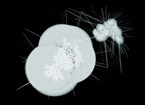
|
doubleCellLia (AT) is the mistress of complex simplicity, of fine lines and elegant motion. Her interactive screen applications demonstrate formal precision and elegance in the way how they respond and transform the users mouse-input into a furioso of streams of pixels and geometric forms. |
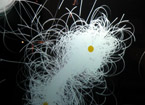
|
TissueThe artist Casey Reas (US) is the creator/programmer of the work Tissue: many little software elements move on the screen, attracted by gravity fields that are positioned with the mouse by the user. On their way, they leave graphical traces that get more and more interwoven into an amazing digital fabric that covers the screen. |
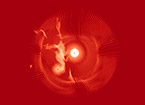
|
Audio Visual Environment SuiteWith his Audio Visual Environment Suite, the artist Golan Levin (US) developed a collection of audio-visual instruments. By arranging and modifiying visual objects and elements on the screen, the user creates a kind of interactive score that is performed in realtime. |
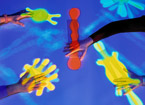
|
Small FishSmall Fish by Masaki Fujihata (JP), Kiyoshi Furukawa (JP) and Wolfgang Münch (DE) consists of 15 different works where movements and collisions of graphical objects and symbols on the monitor generate music. The user can interact with these “games” as if they were musical instruments. “What you see is what you hear”, is the motto of this project. It is the third release from the series “digital_arts_edition”
by ZKM | Karlsruhe. |
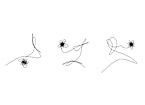
|
TripolarThe work of Scott Snibbe (US) Tripolar simulates a pendulum swinging above three magnets. The program draws the complete path that a pendulum would follow, if it were released above the table exactly at the mouse point. This is a well-known chaotic system – very small changes to the starting position produce large changes to the path. |
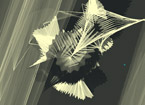
|
3 DotsWith 3 Dots Mark Napier (US) also experiments with algorithms that simulate physical laws. Three connected Dots rotate around each other and create a dense graphical field that expresses in a beautiful way the energy and motion that is unleashed with a few clicks of the user. A fascinating interplay of chaos and order. “Tripolar” by Scott Snibbe and “3 Dots” by Mark
Napier are two works that have been commissioned by the Whitney
Museum’s online exhibition CODeDOC. |

